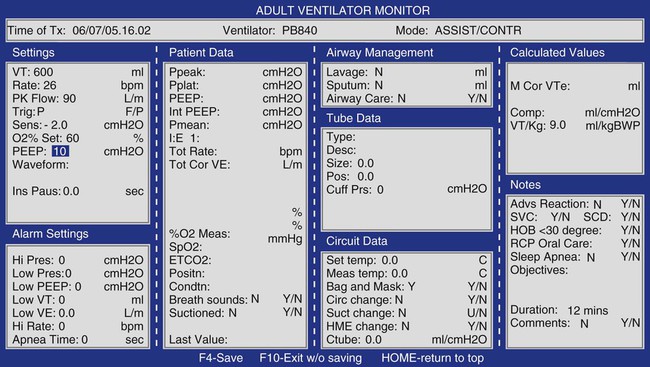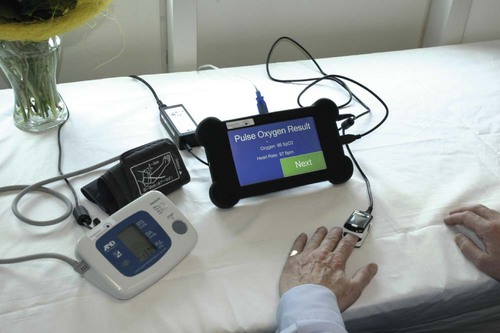After reading this chapter you will be able to: Computer applications are universal in respiratory care, and their impact continues to advance exponentially. Respiratory therapists (RTs) and other members of the health care team rely on computer applications in clinical care, diagnostics, management, education, and research. Emerging computer technology, or eHealth, applications aim to improve the processes of care and the performance of health care providers, engage patients, facilitate care from a distance, and manage information, improving health outcomes. Abundant, accessible, and up-to-date information from the government, universities, publishers, professional organizations, and industry is available to health care providers and patients on the World Wide Web. As established by a task force of the American Association for Respiratory Care (AARC) to chart a vision for the future, RTs will benefit from knowing how to retrieve information efficiently from the best available evidence-based resources.1 RTs have compelling reasons to learn about computer applications. Conventional mechanical ventilators use microprocessors to control flow and pressure for triggering, limiting, and cycling breaths. Some modes of ventilation are closed-loop or adaptive, with predetermined algorithms that take actions automatically within preset limits. Breath-by-breath, microprocessors equilibrate measured values with target values. Based on the lung compliance measured during the previous breath, some modes adjust inspiratory pressure to attain a target tidal volume set by the clinician. New advanced adaptive systems, such as proportional assist ventilation and neurally adjusted ventilatory assist, aim to enhance the patient-ventilator synchrony via automation that is highly responsive to the patient.2 Protocols for ventilator weaning and management of acute respiratory distress syndrome can improve patients’ outcomes; complete, accurate, and consistent documentation of ventilator settings is key. However, manual ventilator charting is frequently incomplete, inaccurate, and inconsistent.3 Computerized ventilator charting applications have the potential to improve the quality and consistency of ventilator charting. Automated ventilator charting, verified by RTs, takes ventilator charting a step further, with the potential to improve completeness, accuracy, consistency, and efficiency.4 Figure 7-1 is an example of a computer screen for automated charting. Evidence-based, patient-driven protocols can improve health outcomes.5,6 Under medical direction and based on patient assessment, RTs use protocols to allocate and titrate respiratory care. Consistency and timeliness of implementation are keys to the effectiveness of protocols. Automation of protocols at the point of care can help RTs address these concerns. An automated protocol for discontinuation of the mechanical ventilation program on hand-held computers can decrease the time to the first spontaneous breathing trial and the length of stay in the intensive care unit (ICU) compared with a protocol without automation.7 At least once a shift, RTs enter information about each mechanically ventilated patient via a hand-held computer. When patients meet preset criteria, the computer program prompts the RTs to conduct a spontaneous breathing trial to help determine the patients’ readiness for ventilator discontinuation. Clinical decision support systems are associated with improved clinician performance, decreased unnecessary care, and adherence to evidence-based clinical practice guidelines.8,9 These systems are particularly useful in preventive care. Computerized reminders increased the proportion of indicated influenza vaccinations, rates of screening, counseling, and adherence to medications. They have also resulted in decreased unnecessary hospital admissions for inappropriately diagnosed cardiac ischemia, appropriately decreased tidal volume and more consistent monitoring of plateau pressure in patients with acute respiratory distress syndrome, and decreased exacerbations in asthma patients.8 Clinical decision support is instrumental in improving clinical outcomes of patients by determining optimal drug dosages. Beneficial outcomes include the following: Telemedicine is the use of telecommunication and computer technology to promote access to diagnosis, monitoring, clinical decision support, and treatment for patients at medically underserved sites that are distant from health care providers. Telemedicine has been effectively implemented in various clinical settings, including home care, emergency departments, and ICUs, and is well accepted by patients.11 Clinical outcomes have generally been similar to traditional health care delivery models; however, in the ICU setting, supplemental telemedicine has been associated with improved clinical outcomes, particularly among the most critically ill patients.12,13 From a distance, on computers either within the hospital or at home, intensive care physicians can see the vital signs, ventilator data, medical record, and diagnostic images of the remote patients. Supplemental telemedicine helps to provide additional support that can potentially result in more rapid recognition of problems and timely, appropriate interventions.14 In the United States, tobacco use and dependence is the leading preventable cause of death and chronic diseases.15 Health care costs attributable to tobacco use are unsustainable. Effective evidence-based treatments are available, but their implementation by health care providers is lagging.16 RTs can play a vital role in the treatment of tobacco-related diseases and should aid in the pursuit of cost-effective ways to help tobacco users. Emerging applications of computer technology, or eHealth applications, are exciting new components of treatment for tobacco use and dependence. With the extensive reach of the Internet and the demonstrated efficacy of some applications, the potential impact on health outcomes is immense. More than 10 million Internet users have searched for online information about how to quit smoking.17 Internet-based treatment programs can recruit tobacco users via search engines, or they can be an adjunct to telephone quitline counseling. Figure 7-2 is a screen shot from the smokefree.gov tobacco treatment website. When eHealth applications are tailored to individual tobacco users, with frequent automated contacts via e-mail or text messages, rates of long-term abstinence from tobacco use are similar to other evidenced-based interventions.18–22 Consistent with the U.S. Public Health Service clinical practice guideline recommendation for a high-intensity, multicomponent approach, an Internet-based application has the capacity to provide both counseling that promotes tailored quit strategies and tobacco cessation medications that have been approved by the U.S. Food and Drug Administration (FDA).16 Internet-based applications can provide unlimited, sustained access to virtually limitless numbers of participants. These applications can be highly cost-effective. Table 7-1 lists some websites related to the treatment of tobacco use and dependence. TABLE 7-1 Websites Related to the Treatment of Tobacco Use and Dependence Management of chronic diseases presents a grave challenge to the U.S. health care system. In the United States, 7 out of 10 deaths are due to chronic disease.23 Chronic disease is present in 8 out of 10 Americans on Medicare, and chronic diseases account for three out of every four dollars of health care expenditures in the United States.24,25 As baby boomers age in the coming decades, the proportion of the U.S. population 65 years old and older is expected to double. There is much interest in addressing the historically disjointed, misallocated processes of chronic disease management through advances in eHealth technologies, to improve health outcomes in a cost-effective manner. In the United States, 60% of households have access to computers, and the availability of broadband access to the Internet is expanding.17 In the United States, which has a population of 311 million people, there are more than 307 million wireless mobile phone connections.26,27 eHealth applications for asthma include interactive Internet applications, such as games for children, Internet applications linked to cell phones for personalized or automated voice or text messaging, and other telemonitoring devices. Many of these applications use monitored patient data to tailor the adjustment of the plan of care. Some provide for personalized goals, calendars, and reminders. Educational tools include audiovisuals and quizzes. In patients with persistent asthma, evidence from research studies shows that these eHealth applications can result in an improvement in asthma knowledge, self-management skills, peak flow rates, and adherence to inhaled corticosteroid controller medications and fewer symptoms, missed school days, nighttime awakenings, activity limitations, emergency department visits, and hospitalizations.28–33 These applications are well received by patients.30 A cornerstone of asthma disease management is assessing patients’ level of control of the disease over time. One validated measure of impairment, recommended by the National Asthma Education and Prevention Program, is the Asthma Control Test.34 This free questionnaire is available in an online format (see www.asthmacontrol.com), which patients can complete and take to a health care provider. Increasingly, chronic obstructive pulmonary disease (COPD) is being managed in the home. Internet-based telemonitoring systems, smartphones, and mobile phones with computer applications extend the reach of health care providers into the home. eHealth applications for patients with COPD facilitates education, self-management, and timely feedback from health care providers (Figure 7-3). Patients generally have a positive attitude about the role of this technology, and the quality of the transmitted data is good.35 Improved outcomes include earlier identification of deteriorating symptoms, better response to exacerbations, increased rate of sustained exercise after pulmonary rehabilitation, and decreased emergency department visits and hospitalizations.35–37 Additionally, eHealth applications can help detect comorbidities, such as sleep apnea.35 The American Thoracic Society recommended pulmonary function reference standards based on the National Health and Nutrition Examination Survey (NHANES). These standards for prediction of normal PFT values may differ from other reference values. This difference can confound the interpretation of successive PFTs in an individual patient when clinicians focus on the computer-assisted interpretation of percent-of-predicted values, rather than the actual observed values.38 Clinicians should have a clear understanding of which reference values were used for each test and interpret PFT results accordingly. Although assessment skills of RTs generally sharpen with experience, their knowledge of the most up-to-date therapies may diminish over time.39 However, the best available medical evidence is dynamic rather than static, and the amount of available information is staggering. A search with the Google search engine using the search word “smoking” yielded more than 169 million results in a fraction of a second. RTs need to be knowledgeable about efficient ways to access, filter, and retrieve information effectively. They must also be prepared to guide increasingly sophisticated patients, many of whom actively seek medical information on the Internet, in retrieving reliable information. The World Wide Web is a far-reaching, rich source of information. RTs can “bookmark” helpful websites for clinical practice guidelines, evidence-based systematic reviews of clinical questions, accrediting agencies, or other relevant sites for rapid retrieval of important information (Table 7-2
Computer Applications in Respiratory Care
 Describe computer applications in clinical care, management, education, and research
Describe computer applications in clinical care, management, education, and research
 Retrieve evidence-based information
Retrieve evidence-based information
Applications in Clinical Care
Mechanical Ventilators

Patient-Driven Protocols
Clinical Decision Support
Telemedicine
Treatment of Tobacco Use and Dependence
Website
Organization
SmokeFree.gov
U.S. Department of Health and Human Services
QuitNet.com
QuitNet
WHO.int/tobacco
World Health Organization, Tobacco Free Initiative
ITCProject.org
International Tobacco Control Policy Evaluation Project
ATTUD.org
Association for the Treatment of Tobacco Use and Dependence
TreaTobacco.net
Society for Research on Nicotine and Tobacco
TobaccoFreeKids.org
Tobacco Free Kids
Management of Chronic Respiratory Diseases
Asthma
Chronic Obstructive Pulmonary Disease
Applications in Diagnostics
Hemodynamic Monitoring
Pulmonary Function Laboratories
Interpretation of Pulmonary Function Tests
Information Retrieval
World Wide Web
![]()
Stay updated, free articles. Join our Telegram channel

Full access? Get Clinical Tree


Computer Applications in Respiratory Care



